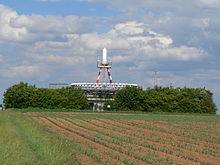The VOR encodes azimuth (direction from the station) as the phase relationship of a reference and a variable signal. The omni-directional signal contains a modulated continuous wave (MCW) 7 wpm Morse code station identifier, and usually contains an amplitude modulated (AM) voice channel. The conventional 30 Hz reference signal is on a 9960 Hz frequency modulated (FM) subcarrier. The variable amplitude modulated (AM) signal is conventionally derived from the lighthouse-like rotation of a directional antenna array 30 times per second. Although older antennas were mechanically rotated, current installations scan electronically to achieve an equivalent result with no moving parts. When the signal is received in the aircraft, the two 30 Hz signals are detected and then compared to determine the phase angle between them. The phase angle by which the AM signal lags the FM subcarrier signal is equal to the direction from the station to the aircraft, in degrees from local magnetic north, and is called the "radial."
This information is then fed to one of four common types of indicators:
- An Omni-Bearing Indicator (OBI) is the typical light-airplane VOR indicator[3] and is shown in the accompanying illustration. It consists of a knob to rotate an "Omni Bearing Selector" (OBS), and the OBS scale around the outside of the instrument, used to set the desired course. A "course deviation indicator" (CDI) is centered when the aircraft is on the selected course, or gives left/right steering commands to return to the course. An "ambiguity" (TO-FROM) indicator shows whether following the selected course would take the aircraft to, or away from the station.
- A Horizontal Situation Indicator (HSI) is considerably more expensive and complex than a standard VOR indicator, but combines heading information with the navigation display in a much more user-friendly format, approximating a simplified moving map.
- A Radio Magnetic Indicator (RMI), developed previous to the HSI, features a course arrow superimposed on a rotating card which shows the aircraft's current heading at the top of the dial. The "tail" of the course arrow points at the current radial from the station, and the "head" of the arrow points at the reciprocal (180 degrees different) course to the station.
- An Area Navigation (RNAV) system is an onboard computer, with display, and up-to-date navigation database. At least two VOR stations, or one VOR/DME station is required, for the computer to plot aircraft position on a moving map, or display course deviation relative to a waypoint (virtual VOR station).
VORTACs and VOR-DMEs use a standardized scheme of VOR frequency to TACAN/DME channel pairing so that a specific VOR frequency is always paired with a specific co-located TACAN or DME channel. On civilian equipment, the VHF frequency is tuned and the appropriate TACAN/DME channel is automatically selected.


